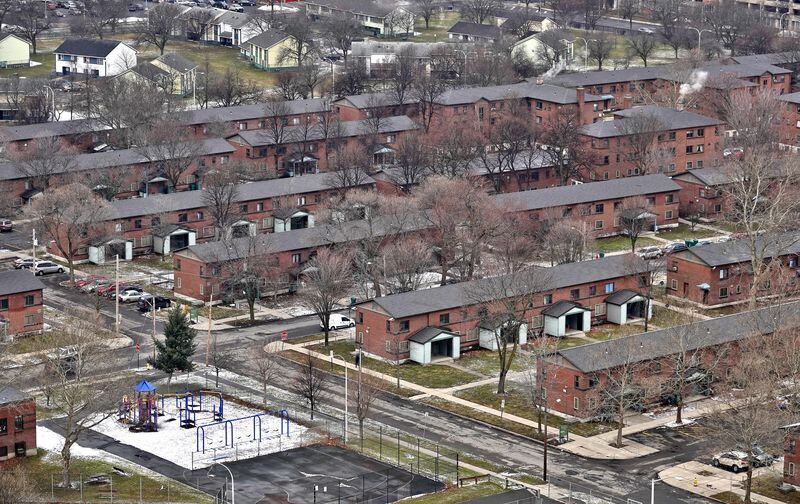
Pioneer Homes, in the area of 1,000 McBride St. was the first development by Syracuse Housing Authority, and one of the first housing projects in the country. March 19, 2019. Michael Greenlar
The state of housing in Syracuse is a crisis. The continuously increased cost of rent and spike in evictions have hit families living in concentrated poverty the hardest. Syracuse’s sole family shelter has been at maximum capacity for the past two years. A growing number of displaced families have resorted to couch surfing, sleeping in motels, cars or outside.
Inflation in the aftermath of the pandemic has exacerbated homelessness. Families are most vulnerable as family units are most scarce. Syracuse is second among large cities for child poverty. One in ten school children are homeless. About 75% of Syracuse families now homeless have never been homeless before.
According to Alex Lawson, the policy director for CNY Fair Housing, landlords drove up prices in response to inflation and the end of the eviction moratorium. The moratorium was a policy that made it extremely difficult for landlords to evict tenants despite failure to pay rent during the pandemic.
Frustrated landlords had raised rent to recoup losses or even in an attempt to get rid of tenants who didn't pay rent during the pandemic. Many landlords and homeowners brought up their prices just because they could according to Lawson.
“There is rebalancing, sort of what happened for home sale prices. For a long time, sellers weren't really trying to find the market price; they were just listing for what they thought someone would buy. What happened during the pandemic, they kind of realized, ‘we can just list it higher than what we think is reasonable, someone else will buy it,’” said Lawson.
When the pandemic ended, government assistance meant to support people through inflation also ended. Communities already living in high rates of poverty have the inflated costs of living on low, stagnant incomes. The average market price of rent has gone up by more than $400 between 2016 and 2023 according to data from Zillow.
Of the 46% of Syracuse households living on less than $35,000 a year, a majority are “cost-burdened,” meaning they spend more than 30% of their income on housing.
“If your housing goes up $400 a month, your income needs to go up by $1200 a month to keep that ratio. Increasing the cost of housing can have a real impact on the ability to maintain a standard of living,” said Lawson.
The most affordable housing options are those in the poorest conditions. One out of three homes in Syracuse are “chronically disinvested.” Many of these homes are extremely old, some deemed uninhabitable by code enforcement and left vacant.
There is a common economic model among some landlords to buy up these inexpensive properties and squeeze them for all they can. These landlords, referred to as “slumlords,” refuse to make necessary fixes to the home when tenants ask because the cost of repair usually outweighs the profit from rent. This could mean a landlord leaves a drafty window unfixed, freezing up the house in the cold winter. Or lead-covered walls not painted over exposes people to lead poisoning.
The majority of tenants rent month to month so landlords can push them out at any time. This may be in retaliation if the tenant complains to Code Enforcement about the condition of the home. A lot of tenants don't know that retaliatory eviction is illegal so they may self-evict if they don’t know their rights.
Landlords may summon tenants who refuse to pay rent in protest to poor conditions left unfixed to eviction court. It’s common for some people to not show up because the name “eviction court” sounds like they’ve already lost according to Lawson.
There isn't really anywhere else to go. According to William Simmons, the director of Syracuse Housing Authority, there are over 2,000 people on the waitlist for public housing. It could take up to two years for a family to get off the waitlist. Thousands that qualify for Section 8 vouchers remain on waitlists.
An increase in newly constructed luxury apartments is another contributor to the increase in the average cost of rent. Although inaccessible to populations most vulnerable to displacement, luxury apartments may free up previously occupied housing.
Zoning codes in Onondaga County restrict the building of apartments and affordable housing in wealthy suburban areas without the permission of municipalities. The approval process is complicated and is usually met with hostility from homogenous suburban residents fueled by the stigma around public housing.
The result is that apartments and affordable and public housing built in confined areas further concentrates poverty established from redlining and suburban sprawl. Outlying suburban areas usually have better opportunities, public services and resources. There is a sense of protecting public resources for a small part of the public, according to Lawson. These benefits are in turn segregated by income and race, feeding into the cycle of poverty.
“The problem in Syracuse is different from like New York City where it’s a housing cost issue, where there’s no housing, it's so expensive. Here the problem is really that people are so poor, there is such low income,” said Lawson.
The Syracuse Housing Authority has announced a plan to build more public housing and rebuild old buildings in the 15th Ward. In the 1960s, Syracuse's Urban Renewal plan built highway I-81 right through the 15th Ward which was home to eight in every nine African American living in Syracuse. Thousands were displaced and poverty was futher concentrated. The project will create close to 1,400 new units designed to house residents of mixed-income to disrupt the concentration of poverty.
According to Lawson, building affordable housing in areas with better access to more resources would better help alleviate the concentration of poverty. Not only does there need to be more government investment, but more intelligent investment.